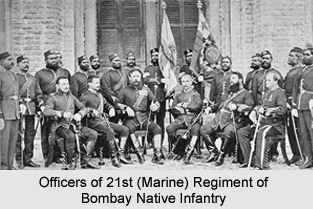 The 21st (Marine) Regiment of Bombay Native Infantry, also known as 121st Pioneers regiment, was an infantry unit of the former British Indian Army. It was founded in 1777 and remained in military service till the year 1922. The military unit was a part of the Bombay Native Infantry. It operated under the Bombay Army of Bombay Presidency till 1895. The Bombay Army was one of the three major Presidency Armies in British India. The 121st Pioneers were also a division of the Bombay Command.
The 21st (Marine) Regiment of Bombay Native Infantry, also known as 121st Pioneers regiment, was an infantry unit of the former British Indian Army. It was founded in 1777 and remained in military service till the year 1922. The military unit was a part of the Bombay Native Infantry. It operated under the Bombay Army of Bombay Presidency till 1895. The Bombay Army was one of the three major Presidency Armies in British India. The 121st Pioneers were also a division of the Bombay Command.
History of 21st (Marine) Regiment of Bombay Native Infantry
The 21st (Marine) Regiment of Bombay Native Infantry was formed in the year 1777 as the Marine Battalion. The troops of the infantry regiment initially took part in the Anglo Persian War. The battalion was sent to the Gulf and participated in the Beni Boo Ali campaign in the year 1821. It fought against the pirates in the Persian Gulf and Eastern Arabia.
The unit then took part in various campaigns, like the conquest of Sindh, the Battle of Hyderabad in the year 1843, the Second Anglo Sikh War in 1848, the Second Anglo Burmese War in the year 1852 and the Military expedition to Abyssinia in 1868. During the First World War, the 21st (Marine) Regiment of Bombay Native Infantry provided military service during the Mesopotamia Campaign and later took part in the Palestine Campaign and the Sinai Campaign.
Development of 21st (Marine) Regiment of Bombay Native Infantry
After World War I, the British Government of India restructured the British Indian Army in the year 1922. As an outcome, several single infantry regiments were unified together in order to form multi battalion large infantry groups that consisted of 4 to 6 battalions. Thus the regiment was renamed as the 10th (Marine) Battalion, 2nd Bombay Pioneers. The 21st (Marine) Regiment of Bombay Native Infantry was dissolved in the year 1932.
Designations of 21st (Marine) Regiment of Bombay Native Infantry
The 121st Pioneers unit of the British Indian Army held many titles through out the reorganisation of the army. These are listed as follows -
* Marine Battalion - 1777
* 1st (Marine) Battalion, 11th Regiment of Bombay Native Infantry - 1818
* 21st (Marine) Regiment of Bombay Native Infantry - 1824
* 21st Bombay Infantry (The Marine Battalion) - 1885
* 121st Pioneers - 1903
* 10th (Marine) Battalion, 2nd Bombay Pioneers - 1922



















